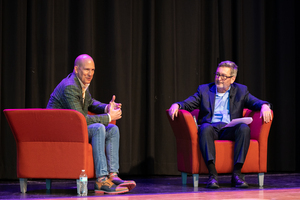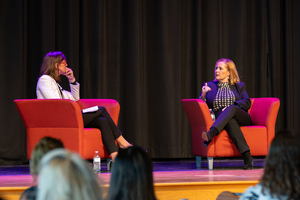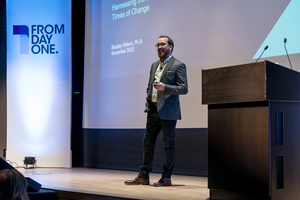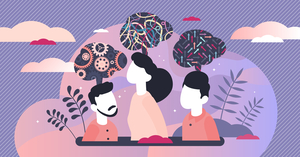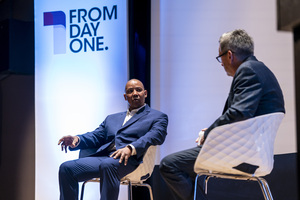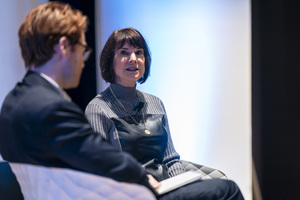Inclusivity in Practice: Shaping Your Company’s Culture
Several decades ago, Sudha Solayappan arrived late for a networking dinner and was seated at the end of a long table. She was much younger than the others, and the two closest people to her were already engaged in conversation.“I felt very awkward,” said Solayappan, now the Head of Talent Operations and People Research at Intuitive Surgical, during a recent panel discussion at From Day One’s Silicon Valley event.Fortunately, another man at the dinner table asked her a question. “What was beautiful about it was that it was a very subtle question he asked, and it was a message to the person to my left as well that I need to be included, but without alienating that person,” Solayappan told panel moderator David Thigpen, a journalism educator at UC Berkeley.Solayappan says this instance was a powerful example of inclusion.The Power of ListeningListening is an essential skill at all levels of an organization to shape an environment of inclusion, says Janine Yancey, founder and CEO of Emtrain.“We’ve all had an experience where the direct line managers are the folks that really create the culture,” she said. “It has to start at the top. But there’s often a big gap between the top and the folks who are influencing day-to-day teams.”The key is to teach all managers to listen more than they talk, says Yancey. She said this involves gently asking simple questions that encourage sharing, such as, “What do you think about that?”Brian Little, VP of human resources at Intel, said the “fight to ensure the quietest voices in the room are heard” is a never-ending challenge, but “unconscious bias training has really helped our company.”For example, a manager once told him that everytime he spoke to someone on his team he experienced frustration. Little recommended unconscious bias training, and the manager realized the way he grew up was interfering with his ability to be a leader. This motivated him to change his behavior, says Little.Building Capacity to Create a Sense of Belonging Another critical step toward developing a culture where everyone feels welcome is building the capacity of each individual, according to Curran Brugger, VP of talent, development, and inclusion at Gilead Sciences.“Our people leaders and our employees generally are just overloaded,” she said. “There’s just so much coming at us.”This makes it difficult for members of an organization to find room on their plates to do the listening and engagement necessary to understand their biases, says Brugger. However, people can adapt to new challenges when they build and broaden their perspective.“You update your operating system over and over and over again, rather than just adding on lots of new operating systems,” Brugger said.The panelists from left to right included Brian Little of Intel, Curran Brugger of Gilead Sciences, Sudha Solayappan of Intuitive, Janine Yancey of Emtrain, and session moderator David Thigpen of UC BerkeleyThis is challenging for many employees from minority groups because their “natural style of being” conflicts with the culture of their workplace, says Solayappan. These individuals develop an “adaptive state” to fit in, but “it really is hard for them. It causes faster burnout,” she said.“How can we increase someone’s capacity when day in and day out that strain is there and they are feeling it? We should make sure that we create a climate where people are comfortable being who they are,” Solayappan said.Measuring Outcomes for InclusivityMany organizations measure their progress on inclusivity through looking at their people, and looking at retention rates, says Yancey. However, she said leaders should also look at social dynamics because they “can make or break you.”“If you have a basketball team with the greatest players in the world but they don’t work well together, they will lose,” Yancey said.She recommends companies begin measuring outcomes during inclusion training. For example, instead of just giving people examples of what allyship and creating opportunities looks like, Yancey advises asking them if their colleagues are doing this or if they have experienced it themselves.By asking those questions, “You’re getting some authentic feedback of what they see and what they’re experiencing in the trenches,” she said. “And you’re mapping it to a set of skills so you can measure those skills at scale and see where you’re strong and where you’re weak.”Company leaders should be aware that a decrease in inclusivity scores might indicate progress because employees feel they are in an environment where it is safe to give constructive criticism, says Brugger.“We’re trying some experiments, and we’re looking at what the data is telling us rather than thinking the data is giving us the answer,” she said. “I think that’s an important distinction on how we’re thinking about metrics.”Companies should consider the big picture when creating inclusivity goals, says Little.“It’s what we want to do in the world, the influence we want to have, how we change the world,” he said. “We will change the lives of a lot of people. There will be kids going to college that didn’t go to college before, there will be parents who all of a sudden will be able to pay all their bills, because if they work for us, they’re going to be doing OK.”Mary Pieper is a freelance writer based in Mason City, Iowa.


